Papers by Alberto d'Onofrio
Communications in Nonlinear Science and Numerical Simulation, 2021

Journal of Pharmacokinetics and Pharmacodynamics, 2016
In this paper we analyze the impact of the stochastic fluctuation of genes between their ON and O... more In this paper we analyze the impact of the stochastic fluctuation of genes between their ON and OFF states on the pharmacodynamics of a potentially large class of drugs. We focus on basic mechanisms underlying the onset of in vitro experimental dose-response curves, by investigating two elementary molecular circuits. Both circuits consist in the transcription of a gene and in the successive translation into the corresponding protein. Whereas in the first the activation/deactivation rates of the single gene copy are constant, in the second the protein, now a transcription factor, amplifies the deactivation rate, so introducing a negative feedback. The drug is assumed to enhance the elimination of the protein, and in both cases the success of therapy is assured by keeping the level of the given protein under a threshold for a fixed time. Our numerical simulations suggests that the gene switching plays a primary role in determining the sigmoidal shape of dose-response curves. Moreover, the simulations show interesting phenomena related to the magnitude of the average gene switching time and to the drug concentration. In particular, for slow gene switching a significant fraction of cells can respond also in the absence of drug or with drug concentrations insufficient for the response in a deterministic setting. For higher drug concentrations, the non-responding fraction exhibits a maximum at intermediate values of the gene switching rates. For fast gene switching, instead, the stochastic prediction follows the prediction of the deterministic approximation, with all the cells responding or nonresponding according to the drug dose.
Physics of Life Reviews, 2016
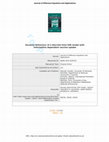
Journal of Difference Equations and Applications, 2015
This paper proposes and analyzes a discrete-time deterministic SIR model with information depende... more This paper proposes and analyzes a discrete-time deterministic SIR model with information dependent immunization behaviour, where vaccination coverage at birth during any period of time is a general phenomenological function of the risk of infection that is perceived at the beginning of the period. Results on existence of equilibria, their local stability, and system persistence are proved. Then, by considering the noteworthy subcase of a piecewise linear "prevalencedependent" coverage function, the local stability of the endemic state is proved and conditions for its global asymptotic stability are given. Some insight on both Neimarck-Sacher and period-doubling bifurcations are provided. Overall we show that prevalence-dependent coverage is an essentially stabilising force. However period-doubling bifurcations are possible though under stressed parameter constellations.
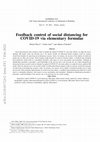
IFAC-PapersOnLine
Social distancing has been enacted in order to mitigate the spread of COVID-19. Like many authors... more Social distancing has been enacted in order to mitigate the spread of COVID-19. Like many authors, we adopt the classic epidemic SIR model, where the infection rate is the control variable. Its differential flatness property yields ele mentary closed-form formulae for open-loop social distancing scenarios, where, for instance, the increase of the number of uninfected people may be taken into account. Those formulae might therefore be useful to decision makers. A feedback loop stemming from model-free control leads to a remarkable robustness with respect to severe uncertainties and mismatches. Although an identification procedure is presented, a good knowledge of the recovery rate is not necessary for our control strategy.Social distancing has been enacted in order to mitigate the spread of COVID-19. Like many authors, we adopt the classic epidemic SIR model, where the infection rate is the control variable. Its differential flatness property yields ele mentary closed-form formulae for open-loop social distancing scenarios, where, for instance, the increase of the number of uninfected people may be taken into account. Those formulae might therefore be useful to decision makers. A feedback loop stemming from model-free control leads to a remarkable robustness with respect to severe uncertainties and mismatches. Although an identification procedure is presented, a good knowledge of the recovery rate is not necessary for our control strategy.
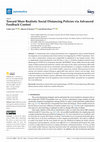
A continuously time-varying transmission rate is suggested by many control-theoretic investigatio... more A continuously time-varying transmission rate is suggested by many control-theoretic investigations on non-pharmaceutical interventions for mitigating the COVID-19 pandemic. However, such a continuously varying rate is impossible to implement in any human society. Here, we significantly extend a preliminary work (M. Fliess, C. Join, A. d’Onofrio, Feedback control of social distancing for COVID-19 via elementary formulae, MATHMOD, Vienna, 2022), based on the combination of flatness-based and model-free controls of the classic SIR model. Indeed, to take into account severe uncertainties and perturbations, we propose a feedback control where the transmission rate, i.e., the control variable, is piecewise constant. More precisely, the transmission rate remains constant during an appreciable time interval. Strict extended lockdowns may therefore be avoided. The poor knowledge of fundamental quantities such as the rate of infection hinders a precise calibration of the transmission rate. T...

SEMA SIMAI Springer Series, 2020
The onset in the last 15 years of behavioral epidemiology has opened many new avenues for epidemi... more The onset in the last 15 years of behavioral epidemiology has opened many new avenues for epidemiological modelers. In this manuscript we first review two classes of behavioral epidemiology models for vaccine preventable diseases, namely behaviour-implicit SIR models with prevalence-dependent vaccination (at birth and among older individuals), and prevalence-dependent contact rate. Subsequently, we briefly propose a general framework of behavior-dependent nonlinear and linear Forces of Infection (FoI) valid for a vast family of infectious diseases, and including delays and 'epidemic memory' effects. Finally and mainly, we develop a new general behavioral SIR model. This model combines the two aforementioned types of behavioral phenomena, previously considered only separately, into a single unified model for behavioral responses. The resulting model allows to develop a general phenomenological theory of the effects of behavioral responses within SIR models for endemic infections. In particular, the model allows to complete the picture about the complicate interplay between different behavioral responses acting on different epidemiological parameters in triggering sustained oscillations of vaccine coverage, risky behavior, and infection prevalence.
Far East Journal of Mathematical Sciences (FJMS), 2019
In this paper we consider an SIRS epidemic model under a general assumption of density-dependent ... more In this paper we consider an SIRS epidemic model under a general assumption of density-dependent mortality. We prove the global stability of the disease-free equilibrium and propose a Lyapunov function that allows to demonstrate the global stability of the (unique) endemic state under broad conditions.
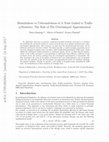
Journal of Mathematical Physics, 2017
An apparently ideal way to generate continuous bounded stochastic processes is to consider the st... more An apparently ideal way to generate continuous bounded stochastic processes is to consider the stochastically perturbed motion of a point of small mass in an infinite potential well, under overdamped approximation. Here, however, we show that the aforementioned procedure can be fallacious and lead to incorrect results. We indeed provide a counterexample concerning one of the most employed bounded noises, hereafter called Tsallis-Stariolo-Borland (TSB) noise, which admits the well known Tsallis q-statistics as stationary density. In fact, we show that for negative values of the Tsallis parameter q (corresponding to sufficiently large diffusion coefficient of the stochastic force), the motion resulting from the overdamped approximation is unbounded. We then investigate the cause of the failure of Kramers first type approximation, and we formally show that the solutions of the full Newtonian non-approximated model are bounded, following the physical intuition. Finally, we provide a new family of bounded noises extending the TSB noise, the boundedness of whose solutions we formally show.
Journal of Theoretical Biology, 2021
Nonlinear Dynamics, 2022
In the behavioral epidemiology (BE) of infectious diseases, little theoretical effort seems to ha... more In the behavioral epidemiology (BE) of infectious diseases, little theoretical effort seems to have been devoted to understand the possible effects of individuals' behavioral responses during an epidemic outbreak in small populations. To fill this gap, here we first build general, behavior implicit, SIR epidemic models including behavioral responses and set them within the framework of nonlinear feedback control theory. Second, we provide a thorough investigation of the effects of different types of agents' behavioral responses for the dynamics of hybrid stochastic SIR outbreak models. In the proposed model, the stochas-A. d'Onofrio is no more affiliated at IPRI since 15 June 2020.
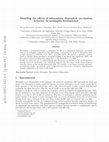
Mathematical Methods in the Applied Sciences
We propose a mathematical model to investigate the effects of information-dependent vaccination b... more We propose a mathematical model to investigate the effects of information-dependent vaccination behavior on meningitis transmission. The information is represented by means of information index as early proposed in (d'Onofrio et al., Theor. pop. biol., 2007). We perform a qualitative analysis based on stability theory, focusing to the global stability of the disease free equilibrium (DFE) and the related transcritical bifurcation taking place at the threshold for the DFE. Finally, we assess the role of epidemiological and information parameters in the model dynamics through numerical simulations. Our simulations suggests that the impact of the human behavior critically depend on the average information delay. For example, it can induce recurrent epidemics, provided that transfer rate from the carrier to the infectious state is over a threshold. Otherwise, the endemic equilibrium is (at least) locally stable.
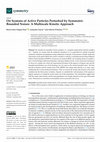
Symmetry
We consider an ensemble of active particles, i.e., of agents endowed by internal variables u(t). ... more We consider an ensemble of active particles, i.e., of agents endowed by internal variables u(t). Namely, we assume that the nonlinear dynamics of u is perturbed by realistic bounded symmetric stochastic perturbations acting nonlinearly or linearly. In the absence of birth, death and interactions of the agents (BDIA) the system evolution is ruled by a multidimensional Hypo-Elliptical Fokker–Plank Equation (HEFPE). In presence of nonlocal BDIA, the resulting family of models is thus a Partial Integro-differential Equation with hypo-elliptical terms. In the numerical simulations we focus on a simple case where the unperturbed dynamics of the agents is of logistic type and the bounded perturbations are of the Doering–Cai–Lin noise or the Arctan bounded noise. We then find the evolution and the steady state of the HEFPE. The steady state density is, in some cases, multimodal due to noise-induced transitions. Then we assume the steady state density as the initial condition for the full sy...

Mathematical Medicine and Biology: A Journal of the IMA
Hesitancy and refusal of vaccines preventing childhood diseases are spreading due to ‘pseudo-rati... more Hesitancy and refusal of vaccines preventing childhood diseases are spreading due to ‘pseudo-rational’ behaviours: parents overweigh real and imaginary side effects of vaccines. Nonetheless, the ‘Public Health System’ (PHS) may enact public campaigns to favour vaccine uptake. To determine the optimal time profiles for such campaigns, we apply the optimal control theory to an extension of the susceptible-infectious-removed (SIR)-based behavioural vaccination model by d’Onofrio et al. (2012, PLoS ONE, 7, e45653). The new model is of susceptible-exposed-infectious-removed (SEIR) type under seasonal fluctuations of the transmission rate. Our objective is to minimize the total costs of the disease: the disease burden, the vaccination costs and a less usual cost: the economic burden to enact the PHS campaigns. We apply the Pontryagin minimum principle and numerically explore the impact of seasonality, human behaviour and latency rate on the control and spread of the target disease. We foc...

Ricerche di Matematica
Mathematical models of the spread and control of infectious diseases in humans should not simply ... more Mathematical models of the spread and control of infectious diseases in humans should not simply be mathematically interesting. They ought also to provide some qualitative or quantitative information that can in some way be of interest for public health. In many cases, even simple mathematical models have been able to fulfill the difficult task of providing help to public health scientists to better understand the interplay/interdependence between the dynamics of the disease and the control measures to be enacted. Four pillars of public health campaigns for controlling the spread of infectious diseases are: treating infectious humans; vaccination to prevent infection; reduction of risky behaviors; and vector control, in the case of vector borne diseases. All these pillars depend on various factors of heterogeneity that must be taken into account if we want to pass from a vague utility to some more robust role for mathematical epidemiology. The first heterogeneity factor is the age structure of population. First and foremost, the risk of disease-induced mortality for many diseases is age dependent, with children and elderly with a higher risk of fatality. The pattern of contacts is also strongly B B. Buonomo

Journal of Mathematical Biology
In order to seek the optimal time-profiles of public health systems (PHS) Intervention to favor v... more In order to seek the optimal time-profiles of public health systems (PHS) Intervention to favor vaccine propensity, we apply optimal control (OC) to a SIR model with voluntary vaccination and PHS intervention. We focus on short-term horizons, and on both continuous control strategies resulting from the forward-backward sweep deterministic algorithm, and piecewise-constant strategies (which are closer to the PHS way of working) investigated by the simulated annealing (SA) stochastic algorithm. For childhood diseases, where disease costs are much larger than vaccination costs, the OC solution sets at its maximum for most of the policy horizon, meaning that the PHS cannot further improve perceptions about the net benefit of immunization. Thus, the subsequent dynamics of vaccine uptake stems entirely from the declining perceived risk of infection (due to declining prevalence) which is communicated by direct contacts among parents, and unavoidably yields a future decline in vaccine uptake. We find that for relatively low communication costs, the piecewise control is close to the continuous control. For large communication costs the SA algorithm converges towards a non-monotone OC that can have oscillations.

The COVID-19 pandemic is spreading worldwide. Italy emerged early on as the country with the larg... more The COVID-19 pandemic is spreading worldwide. Italy emerged early on as the country with the largest outbreak outside Asia. The outbreak in Northern Italy demonstrates that it is fundamental to contain the virus' spread at a very early stage of diffusion. At later stages, no containment measure, even if strict, can prevent the saturation of the hospitals and of the intensive care units in any country. Here we show that it is possible to predict when the intensive care units will saturate, within a few days from the first cases of COVID-19 intensive care patients. Using early counts of intensive care patients, we predict the saturation for Lombardy, Italy. Governments should use the Italian outbreak as a precedent and implement appropriate containment measures to prevent the saturation of their intensive care units and protect their population, also, and above all, in anticipation of a possible second rapid spread of infections.
Electronic Proceedings in Theoretical Computer Science

Uploads
Papers by Alberto d'Onofrio